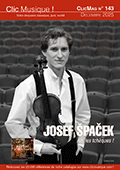|
Eva Saladin détient un pouvoir magique : de son archet, elle transfigure tout ce qu'elle touche. Elle avait déjà révélé à nos oreilles émerveillées un Pandolfi Mealli injustement oublié. C'est maintenant au tour de Francesco Maria Veracini. Ce compositeur, florentin de naissance, exerça son art à Venise, Londres, Düsseldorf, Dresde, Prague...et son existence mouvementée fut marquée entre autres par une tentative de suicide et un naufrage. Il toucha à tous les genres : concerto, opéra, oratorio...De son vivant, il était surtout reconnu comme un des plus grands virtuoses du violon, mais dans cet album il se révèle comme un poète de l'archet. Ses sonates qui n'ont d'académique que le nom furent publiées à Londres et à Florence en 1744. Qu'elles soient dansantes ou rêveuses, populaires ou galantes, joyeuses ou nostalgiques, elles ne sont jamais banales. L'art de Saladin exalte donc celui de Veracini, ce qui nous offre un album plein d'un charme rare, d'élégance et de variété. (Marc Galand)  Florentine, born Francesco Maria Veracini (1690-1786), was considered one of the greatest violin virtuosos of his day. Periods of residence in London, Düsseldorf, Venice, and Dresden brought the eccentric musician international fame. Amongst his extensive output, his Sonate Accademiche Op. 2 (London/Florence 1744) for violin and basso continuo are the best known today. The character of the Sonate Accademiche is defined by a peculiar combination of the intellectual, the virtuosic, and the highly expressive. Despite the technically demanding writing for the violin, Veracini’s masterfully idiomatic approach to his own instrument means the virtuosity flows with a natural ease and playfulness. The Sonate Accademiche collection is vast in terms of its length and variety. The sonatas do not adhere to the standard forms of the day, such as the Italian sonata da camera or sonata da chiesa. Veracini himself in his own preface: "... two, or even three movements, chosen at one’s own discretion, are sufficient to form a sonata of appropriate length." Eva Saladin has applied Veracini’s approach to the entire book, which allows her to choose contrasting parts of sonatas and to highlight the most interesting features of the music by combining individual movements into a flowing programme with connecting tonalities and a clear dramaturgy.
 |
